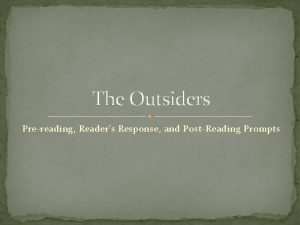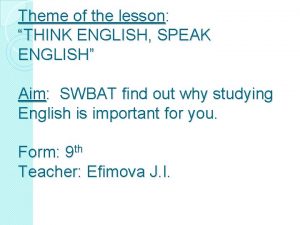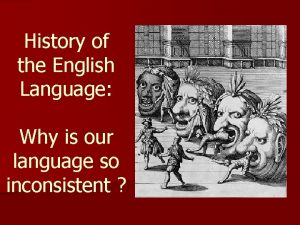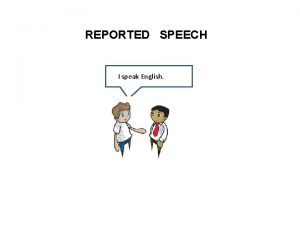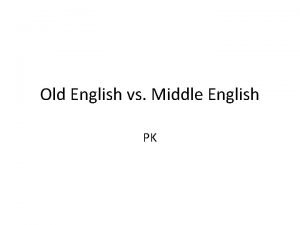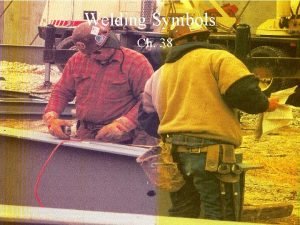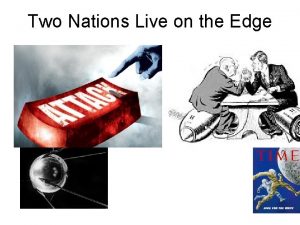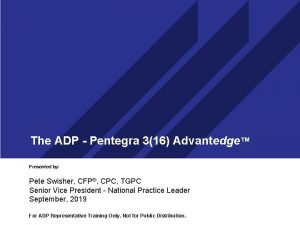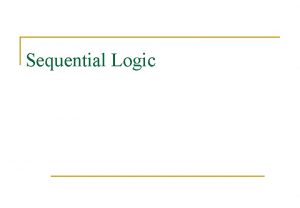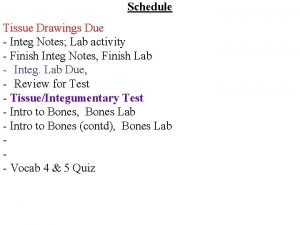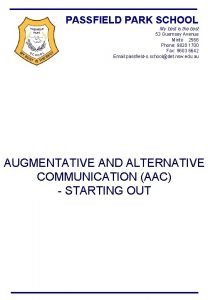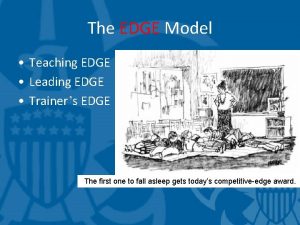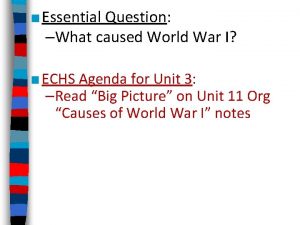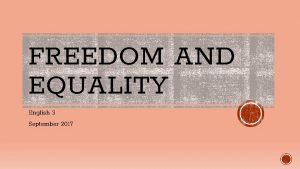C Edge ECHS English I Quickwrite p 266












































- Slides: 44

C. Edge ECHS English I

Quickwrite, p. 266 n The grown-ups in this story have plenty of reasons to sing the blues. One of their problems comes from a cameraman who wants to take pictures of them. Jot down quickly your feelings on the ways the media sometimes interfere with people’s private lives and private sufferings. Then, think about why people like to watch other people’s troubles on television.

Literary Elements n n Anecdote – a very brief account of an incident Example from the story

Literary Elements n n Conflict – struggle or clash between opposing characters or opposing forces Describe the conflict between Granny and the film crew

Literary Elements n Characters – persons in a story, poem, or play n n Flat character – one that has only one or two traits, and these can be described in a few words. Round character – a character that is like a real person, having many different character traits, which sometimes contradict one another

Literary Elements n n Dialect – way of speaking that is characteristic of a particular region or a particular group of people Examples of dialect from the selection:

Literary Elements n Generalization – a statement made from an inference (a general principle, trend, etc. ) of particular facts, statistics, or the like; or from only a few facts, examples, or the like.

Literary Elements n n Imagery – language that appeals to the senses Identify two images that appeal to the five senses in this story.

Literary Elements n n Point of view – the relationship of the narrator to the story being told What point of view is the story told from?

Literary Elements n n Symbol – person, place, thing, or event that stands for itself and for something beyond itself as well What do the hawks symbolize in the story?

Literary Elements Theme – the central idea of a story n n Read p. 264 -5 in the literature book about theme. NOT THE SAME THING AS THE SUBJECT! What is a possible theme for this story?

Literary Elements n n Title – the name of the story; it reveals something about the meaning of the story What is the significance of the title of this story?

Summary Two insensitive filmmakers who are making a documentary about the food stamp program invade the privacy of Granny and Granddaddy Cain, a proud and dignified older couple. The filmmakers have good intentions, but they don’t treat the Cains with the proper respect. Without asking for permission they pry into the family’s personal life, filming their rural home and disturbing their routine. The narrator and other children watch as Granny and Granddaddy Cain repeatedly but politely rebuff the filmmakers. When Granny Cain finally tells her husband to make the men leave, he resolves the conflict by removing the film from their camera.

Dialect, p. 268 n n Identify all of the words in the first three sentences that omit the final consonant g on – ing forms. This pattern marks the dialect that is used in the story.

Making Generalizations, p. 268 n n What details support the generalization that the family has moved many times? The speaker talks about having lived in three places: “the Judson’s woods, ” “the Cooper place, ” and “the dairy. ”

Dialect, p. 268 n n n Ain’t is used in place of standard English isn’t or aren’t. Which standard English word is replaced by ain’t in this sentence? aren’t

Conflict and Character, p. 268 n n n What conflict emerges between Granny and the film crew? They want to use the Cain home in their film, but Granny doesn’t want them on her property. How can you tell that it never occurred to the filmmakers to ask permission? They just start shooting pictures, and even though one man seems embarrassed, they don’t really understand why Granny is so annoyed. What do Granny’s expressions, tone of voice, and words tell you about how she feels? Use details from the story to support your response. She is upset with the filmmakers and wants them to realize they are invading the family’s privacy. “that smile” and the way she interrupts the filmmakers.

Making Generalizations, p. 268 n n n Why was the person with the camera saving some shots? Why does Cathy say, “Of course”? Somebody insensitive enough to shoot photographs in the first place would save a few in order to capture the person’s jump. Cathy is perceptive and understands Granny’s point. How does Granny’s story connect with what is happening in her yard? The photographers on her property are equally insensitive. What does she want to teach her grandchildren? She wants them to understand that it is degrading and insensitive to treat people as objects whose lives are of meaning only as a way to excite or entertain others.

Making Generalizations, p. 270 n n Think about what all of the events described here have in common. Exactly what do people do that disturbs Granny so much? Granny is driven crazy by people’s condescension, presumption, insensitivity, and lack of respect for her family’s privacy.

Point of View, p. 270 n The story is narrated from the first-person point of view, but this point of view is enlivened and enriched by how the writer makes use of several other characters’ observations. The twins make childish but natural comments, often asking obvious questions. Cathy makes sophisticated comments that supplement the narrator’s own fresh and humorous insights.

Descriptive Details, p. 270 n n n n What vivid details in this paragraph help you see and hear the action? “the shiny black oilskin, ” “what little left there was of yellows, reds, oranges, ” “great white head, ” “the sound of twigs snapping overhead and underfoot” “tall and quiet and like a king” “drippin red down the back of the oilskin” The hammerin crackin through the eardrums”

Summarizing, p. 272 n n How does Granddaddy Cain kill the male hawk? He throws the hammer and strikes the hawk in the air.

Symbols, p. 273 n n n The scenes about the suffering hawks take up a good part of the story. How can one or both of the hawks be seen as symbols that stand for some of the characters in the story? Camera and Smilin? Granny and Granddaddy?

Character, p. 273 n n What do you learn about Granddaddy Cain here? That even when he is exasperated with people like the filmmakers, he can exercise selfcontrol and respond in a polite manner.

Character, p. 273 n n What kind of character traits do Camera and Smilin show? They are rude, condescending, and presumptuous; they are not sensitive to the feelings of others; they are ignorant about how other people feel.

Theme, p. 273 n n Granddaddy Cain’s words suggest the major theme of the story—a truth about how people should treat each other. In your own words, what is that theme? People should have respect for the feelings and property of others.

Selection Questions n Who is around when the story begins? n Cathy, Tyrone, Terry, and Granny.

Selection Questions n n What is Granny doing at the beginning of the story? Pouring rum into the Christmas cakes.

Selection Questions n n What else has the ladle been used for? Dripping maple syrup into the pails (Judsons’ woods), pouring cider into vats (the Cooper place), and scooping buttermilk and soft cheese (the dairy). What does this tell us? The family has moved a lot in order to find work and make a living.

Selection Questions n n Who are Smilin’ and Camera? Filmmakers from the county making a film about the welfare program.

Selection Questions n n What are the two men doing? They are taking pictures of Granny and her property without permission. Who do they work for? The county.

Selection Questions n n How does Granny feel about reporters? She does not appreciate their disrespect and invasion of their privacy. What event made her feel this way? She saw a man on a bridge about to commit suicide. There was a cameraman there taking pictures, but saving a few pictures for the jump.

Selection Questions n n Who appears out of the woods? Granddaddy Cain. What does he have in his hands? A bloody chicken hawk.

Selection Questions n n What amazing feat does Granddaddy Cain do? He kills the chicken hawk’s mate by hitting it with a hammer.

Selection Questions n n n What is the only thing he says? “Good day, gentlemen. ” “You standin in the missus’ flower bed. ”

Discussion Question n How effective is Bambara’s use of a first person point of view? Do we get the whole story? How would the story have been different if the narrator would have been a third person limited or omniscient?

p. 275, Question #1 n n Which detail of the story was the most memorable for you? Was it an image, a statement, a character, or something else? Pair up with another student and share your major memory from the story. Possible answers: Granny’s telling the filmmakers to turn off their camera. Granddaddy’ arrival home, his killing of the second hawk, or his exploring the film.

p. 275, Question #2 n n When Smilin and Camera return to the county office, what do you think they tell their supervisor? How do you think they portray the characters of Granny and Granddaddy Cain? Camera and Smilin will most likely blame Granddaddy and Granny for the ruined film. Since they don’t recognize their own insensitivity, they will probably portray Granny and Granddaddy as eccentric and belligerent.

p. 275, Question #3 n n Here you ever said one thing while thinking something else? What do you imagine Granddaddy Cain is thinking when he says, “Good day, gentlemen”? What about when he says, “You standing in the missus’ flower bed. This is our own place”? Possible answer: He is probably thinking about how angry he is and how he would like to throw the men off his property.

p. 275, Question #4 n n Writers create powerful impressions with concrete dramatic images. What do the suffering hawks in the story suggest to you? (Are they like any characters in the story? ) Possible answer: The hawks fight desperately, suggesting courage and strength. They are like Granddaddy and Granny Cain, who fight to protect their family, property, and privacy.

p. 275, Question #5 n State theme of the story in the form of a generalization about our lives—that is, what does the story reveal to you about our need for respect and sympathy and privacy? Consider these elements of the story: n n The title The anecdote, or little story, Granny tells about the man on the bridge Cathy’s anecdote, or little story, about Goldilocks Possible themes: People should respect the privacy and property of others; people can get through troubles with strength and dignity. The title says that the blues, unlike the mockingbird, do not suggest self-pity or death. The anecdote about the man on the bridge reveals Granny’s disgust with people who take advantage of the misfortunes of others. Cathy’s version of Goldilocks shows an intruder having no respect for the property or privacy of others.

p. 275, Question #6 n n What did you learn about the first-person narrator in this story? What else would you know if Granny or her husband were narrating the story? The narrator is a young girl who lives with her grandparents. If Granny of her husband told the story, we would know about their inner thoughts when they confront the filmmakers.

p. 275, Question #7 n n A family’s privacy is invaded in this story. Invasion of privacy has become commonplace in today’s media. When have you felt that someone’s privacy was invaded by TV cameras or reporters? What would you do if you were in Granny’s situation? (Be sure to refer to your Quickwrite notes. ) Students may mention public figures whose personal lives have been made public. In Granny’s situation, students might call the family inside and lock the doors, call the police, or react much as Granny does.

Link to Other Resources n http: //go. hrw. com/hrw. nd/gohrw_rls 1/p. Keywo rd. Results? le 0%209 -4. 2
 Outsiders writing prompts
Outsiders writing prompts Avid quick write prompts
Avid quick write prompts Echs visakhapatnam
Echs visakhapatnam Rising edge and falling edge
Rising edge and falling edge Qr266
Qr266 Assignment chem 266
Assignment chem 266 Round off to the nearest hundred 695
Round off to the nearest hundred 695 A number rounded to the nearest hundred thousand is 400 000
A number rounded to the nearest hundred thousand is 400 000 E 266
E 266 Think in english speak in english
Think in english speak in english Spoken english and broken english
Spoken english and broken english Semantic change
Semantic change Father of the tragedy
Father of the tragedy Old english vs modern english
Old english vs modern english Differences between americans and british
Differences between americans and british Vocabulary differences in british and american english
Vocabulary differences in british and american english Old english vs modern english
Old english vs modern english Bella said i speak english
Bella said i speak english Fæder ure þu þe eart on heofonum
Fæder ure þu þe eart on heofonum The gap between written and spoken english
The gap between written and spoken english The difference between american and british english
The difference between american and british english Open edge computing
Open edge computing Spot weld symbol definition
Spot weld symbol definition Find the lateral area and surface area of each prism
Find the lateral area and surface area of each prism Vray curvature
Vray curvature Time cover
Time cover Radial shakes in timber
Radial shakes in timber River edge after school program
River edge after school program Adpweb/adp expert
Adpweb/adp expert Tandberg edge 95
Tandberg edge 95 Converged edge systems
Converged edge systems Bolt gage spacing
Bolt gage spacing Solid edge training
Solid edge training Solid edge alternate assemblies
Solid edge alternate assemblies Firmer chisel diagram
Firmer chisel diagram Positive level triggering
Positive level triggering Free edge
Free edge The curved sealed edge between floor and wall
The curved sealed edge between floor and wall Edge royal rumble 2010
Edge royal rumble 2010 Half rhyme
Half rhyme Jp morgan receivables edge
Jp morgan receivables edge Trail edge modulation
Trail edge modulation Pci anchor
Pci anchor Fist edge palm
Fist edge palm Edge coverage example
Edge coverage example
